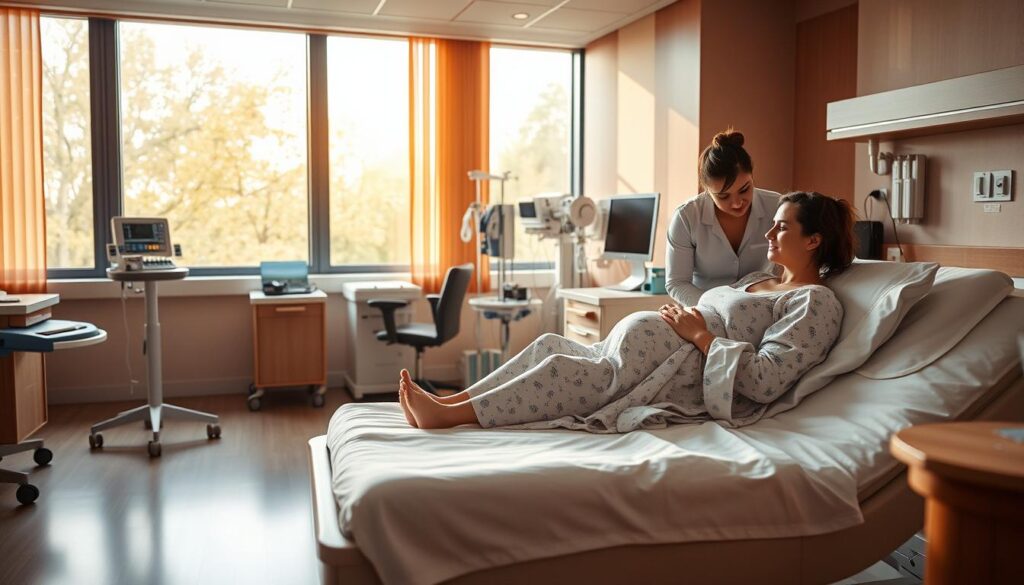NHS birth options allow expectant mothers to choose where to give birth—at home, in a hospital, or a midwife-led birth centre—based on their health and preferences. Each birth setting has unique benefits and limitations. Understanding these can help you make a confident and informed decision.

You can choose to have your baby at home, in a midwife-led birth centre, or in a hospital. Each place has its good points and not-so-good points. Knowing these can help you decide where to have your baby.
The NHS has many options for giving birth. You can pick the comfort of your home or the safety of a hospital. There’s something for everyone.
Key Takeaways
- Expectant mothers have multiple NHS childbirth options.
- The choice of where to give birth depends on individual needs and risks.
- Hospital births, midwife-led birth centres, and home births are available.
- Each option has its pros and cons.
- Eligibility criteria vary depending on the chosen option.
Your Birth Setting: Why It Matters
The place where you give birth is very important. It can change how you feel during and after labour. Choosing the right setting is a big decision.
The Impact of Environment on Your Birth Experience
A good birth environment can make you feel more at ease. This might make the birthing process easier. The NHS knows this and tries to offer different options for everyone.
How the NHS Supports Birth Choice
The NHS helps you choose where to give birth. You can pick from hospitals, birth centres, or even home births. Your midwife will talk about what’s available in your area.
You can change your mind about where to give birth at any time. The NHS wants to make sure you have a good birthing experience, no matter where you choose.
Hospital Births: Comprehensive Medical Care
Many expectant mothers choose hospital births for the medical care they offer. Hospitals are safe, especially for those with high-risk pregnancies or health issues.
What to Expect in an NHS Labour Ward
In an NHS labour ward, midwives will watch over you and support you during labour. If problems come up, doctors are there to help. The ward has the latest medical tools to ensure the best care for you and your baby.
Key facilities in an NHS labour ward include:
- Monitoring equipment for tracking the baby’s heart rate and mother’s vital signs
- Birthing pools for pain relief
- Advanced life support systems for emergencies
Advantages of Hospital Births
Hospital births offer quick access to medical help. This is great for women with health issues or complications during labour. A team of experts ensures both mother and baby get the care they need.
“The safety and medical support available in hospitals make them an attractive option for many expectant mothers.” – NHS Choices
Potential Drawbacks of Hospital Settings
Some women might find hospital births less natural. The clinical setting and chance of interventions might not fit their birth plan.
| Aspect | Hospital Birth |
| Medical Care | Comprehensive and immediate |
| Environment | Clinical, with advanced equipment |
| Interventions | More likely due to the medical setting |
Who Is Hospital Birth Most Suitable For?
Hospital birth is best for women with high-risk pregnancies, health issues, or past complications. The medical care available makes it a safe choice for them.
Midwife-Led Birth Centres: The Middle Ground
Expectant mothers looking for a mix of home comfort and medical safety find midwife-led birth centres appealing. These places aim to mimic home, focusing on natural births with minimal medical help.
Alongside Midwifery Units vs. Freestanding Birth Centres
Midwife-led birth centres are either alongside midwifery units or freestanding. Alongside units are close to hospitals, ensuring quick medical help. Freestanding birth centres are separate but still ready for normal births.

Benefits of Midwife-Led Care
Midwife-led care offers a more personal touch, fewer medical interventions, and a home-like setting. It helps women have simpler births, making the experience more empowering.
Limitations to Consider
Despite their benefits, midwife-led birth centres have limits. They’re best for women with uncomplicated pregnancies.
Eligibility for Birth Centre Delivery
Women with normal, singleton pregnancies are usually eligible for birth centre delivery. The exact rules depend on the NHS trust and local guidelines.
| Feature | Alongside Midwifery Units | Freestanding Birth Centres |
| Location | Within or near a hospital | Separate from a hospital |
| Medical Backup | Immediate access | Transfer arrangements in place |
| Environment | Homely, within a hospital setting | Homely, standalone facility |
Choosing Where to Give Birth: NHS Options for Expectant Mothers
Deciding where to give birth is a big choice. The NHS offers several options, including home births. It’s important to know what’s available under the NHS.
Home Births: Bringing Baby into Your Environment
A home birth lets you give birth in your own home. You’re surrounded by family and familiar things. This can make the birthing process feel more personal and relaxed.

Advantages of Home Birth
Home births are comfortable and flexible. You’re more likely to feel relaxed in your own space. This can help the birthing process. Plus, you have more control over who’s there and how you manage your labour.
Safety Considerations and Support Available
Home births are safe for women with straightforward pregnancies. But, having the right support is key. Your midwife will be there and have access to your medical records. They’re ready for any emergencies.
Who Is Eligible for Home Birth?
Home birth is usually for women with straightforward pregnancies. Both the mother and baby must be healthy. Your healthcare provider will check if you’re eligible during your pregnancy.
| Birth Setting | Advantages | Safety Considerations |
| Home Birth | Increased comfort, more control over the birthing environment | Generally safe for straightforward pregnancies, requires proper medical support |
| Hospital Birth | Comprehensive medical care available, suitable for high-risk pregnancies | May feel less personal, more interventions possible |
| Midwife-Led Birth Centres | Offers a more homely atmosphere than hospitals, still provides medical care | May not be suitable for high-risk pregnancies, transfer to hospital may be needed |
Conclusion: Making Your Informed Decision
Choosing where to give birth is a personal choice. It depends on your health, what you prefer, and your situation. The NHS offers different places to give birth, like hospitals, birth centres, and home births.
By looking at the good and bad of each option, you can decide what’s best for you. This way, you can make a choice that suits your needs.
You can change your mind about where to give birth at any time during pregnancy. If you’re not sure or want to learn more, talk to your midwife. They can help you understand your options and support your decision.
Being well-informed and prepared is key to a good birth experience. By thinking carefully about your choices and getting advice from your midwife, you’ll feel confident. This will help you have a safe and healthy delivery.



